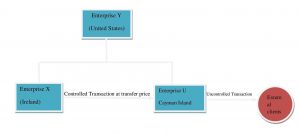 Transfer pricing is a method multinational corporations use to shift profits from high to low tax jurisdictions (countries). Transactions usually involve the transfer of goods and services. These companies use transfer pricing to allocate profits (earnings before interest and taxes) among their various subsidiaries within the organization. For instance, if a subsidiary company X in the United States sells goods to its Subsidiary Y in Cayman Island, we call the price charged between the parties transfer price.
Transfer pricing is a method multinational corporations use to shift profits from high to low tax jurisdictions (countries). Transactions usually involve the transfer of goods and services. These companies use transfer pricing to allocate profits (earnings before interest and taxes) among their various subsidiaries within the organization. For instance, if a subsidiary company X in the United States sells goods to its Subsidiary Y in Cayman Island, we call the price charged between the parties transfer price.
It can either occur between related enterprises and unrelated enterprises. Control transactions occur between related parties, whereas uncontrolled transactions between independent parties are called uncontrolled transactions. These transactions usually include;
- Finances such as guarantees and loans
- Tangible property
- Services like routine
- Intangible property such as customer lists, patents, and trademarks
Now that we understand the concept of related parties. The following graph shows this in practice.

Why is transfer pricing Important?
Now that we have understood what it is. But why is it important? Each country has different tax rules and rates which may cause friction between tax authorities and multinational corporations across various jurisdictions. So multinational seeks to use transfer pricing too;
- Reduce chances of double taxation
- Avoid controversy
- Minimize effective tax rates
- Repatriate cash effectively
And tax authorities use transfer pricing too;
- Maximize tax revenue
- Prevent tax avoidance
- Determine reasonable prices for transactions.
- Prevent profit sharing
Transfer pricing aims is to address tax confusion happening among companies performing international business proactively. Its goal is to reduce tax compliance risk and potentially minimize companies’ net effective global tax burden.
What is Arm’s Length Principle (ALP?)
Most countries have transfer pricing rules in their domestic tax laws. These rules are called the Arm’s length principle. According to Organization for Economic and Co-operation Development(OECD), ALP means prices charged between related parties (controlled transactions) should be the same as those charged by independent parties (uncontrolled transactions).
The purpose of Arm’s length principle is to avoid any artificial manipulation of profits for tax purposes. For instance, goods sold.
So, how can you determine the Arm’s length principle during transfer pricing applicable?
Here are steps to follow for transfer pricing analysis.
- Getting relevant facts that is functional analysis
- identify useful comparable transactions that are comparability analysis
- Select the most appropriate transfer pricing method.
How to perform a functional analysis
This is the process of identifying and analyzing the significant economic functions executed by parties. To achieve fairness, a functional analysis must be performed. This looks into the company’s functions, assets, and risks. Elements of functional analysis include:
- Identifying and understanding all the overall processes through which multinational enterprises create value.
- Identifying cross-border transactions between associated parties.
- . Identifying specific terms of transactions between the associated parties
- Analyzing transactions performed, assets used, and risk assumed by both parties.
The functional analysis seeks to answer questions such as:
- What are the company earnings?
- What are people doing within the company?
- Do other countries in what the company is doing?
- Are there any risks associated with the company’s work?
Transfer pricing is terms and conditions that related enterprises use to control their transactions. These prices affect the amount of tax these enterprises pay. Transfer pricing provides rules which aim to prevent profit shifting from high tax jurisdictions to low-tax jurisdictions. Thus, proper compliance by multinational corporations may help them avoid big financial exposures.



